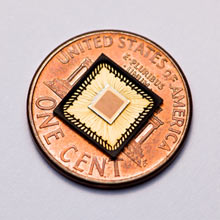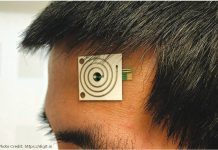
A probability-based processor may speed up flash memory, and eventually much more. A computer chip that performs calculations using probabilities, instead of binary logic, could accelerate everything from online banking systems to the flash memory in smart phones and other gadgets.
Rewriting some fundamental features of computer chips, Lyric Semiconductor has unveiled its first “probability processor,” a silicon chip that computes with electrical signals that represent chances, not digital 1s and 0s.
“We’ve essentially started from scratch,” says Ben Vigoda, CEO and founder of the Boston-based startup. Vigoda’s PhD thesis underpins the company’s technology. Starting from scratch makes it possible to implement statistical calculations in a simpler, more power efficient way, he says. And because that kind of math is at the core of many products, there are many potential applications. “To take one example, Amazon’s recommendations to you are based on probability,” says Vigoda. “Any time you buy [from] them, the fraud check on your credit card is also probability [based], and when they e-mail your confirmation, it passes through a spam filter that also uses probability.”
All those examples involve comparing different data to find the most likely fit. Implementing the math needed to do this is simpler with a chip that works with probabilities, says Vigoda, allowing smaller chips to do the same job at a faster rate. A processor that dramatically speeds up such probability-based calculations could find all kinds of uses. But Lyric will face challenges in proving the reliability and scalability of its product, and in showing that it can be easily programmed.
The electrical signals inside Lyric’s chips represent probabilities, instead of 1s and 0s. While the transistors of conventional chips are arranged into components called digital NAND gates, which can be used to implement all possible digital logic functions, those in a probability processor make building blocks known as Bayesian NAND gates. Bayesian probability is a field of mathematics named after the eighteenth century English statistician Thomas Bayes, who developed the early ideas on which it is based.
Whereas a conventional NAND gate outputs a “1” if neither of its inputs match, the output of a Bayesian NAND gate represents the odds that the two input probabilities match. This makes it possible to perform calculations that use probabilities as their input and output.
Lyric has been working on its technology in stealth mode since 2006, partly with funding from the U.S. Defense Advanced Research Projects Agency. DARPA is interested in potential defense applications that would involve working with information that isn’t clear cut–for example, radio signals distorted accidentally or otherwise, and machine vision systems that try to recognize actions or objects in images. “They’re interested in some James Bond-type applications,” says Vigoda.
Within three years, Lyric plans to produce prototypes of a general-purpose probability processor, dubbed GP5, capable of being programmed to take on any statistical task. But Lyric’s first chip, on offer to companies using flash memory in devices and products available to license from this week, is targeted at boosting the efficiency, and ultimately the size, of the solid state flash memory at the heart of portable gadgets like smart phones and tablets.
Flash memory chips store data using areas of charge trapped on their surface. But those clumps are unstable and even small changes in charge can affect the integrity of the stored data. “The difference between a 0 and a 1 is just 100 electrons,” says Vigoda. “Today, one in every 1,000 bits is wrong when it is read out, and in the next generation, the number of errors will approach one bit in every hundred.”
Error-checking chips can correct those errors by drawing on a unique code generated every time data is written to the chip. This checksum can be used to confirm whether the stored data has changed, and makes it possible to calculate which bits have flipped from 1s to 0s or vice versa. This requires the kind of statistical calculation that is difficult to implement in digital logic, says Vigoda, but is ideal for Lyric’s approach.
The firm has been testing a probability chip’s ability to perform error checks with one of the largest flash memory manufacturers. Compared to a typical error-correction chip used today, Lyric’s chip takes up just a 30th of the space and uses a 12th of the energy. “We hope you’ll be walking around with this in your pocket within two years,” says Vigoda.
Error checking is becoming a bottleneck for flash performance and capacity, says Steven Swanson, a computer scientist at University of California, San Diego who studies the performance of flash chips. Hard disks, based on spinning magnetic platters, to a large extent owe their gains in capacity over recent years to advanced error checking being built in, says Swanson. “Compared to [hard disks], we’re still in the early days for flash,” says Swanson, “and it is pretty clear that as flash gets denser, error checking will become more important.”
Although Lyric’s probability chips could connect to conventional electronics, they work in a fundamentally different way, which may create some speed bumps in the minds of engineers, says Swanson. “As a flash engineer, I might find myself wanting to test more of these unusual chips than I would a conventional one to convince myself they are reliable.”




Hi, can I quote some of the content found in this entry if I provide a link back to your site?
Just stumbled upon your article and will have a look at additional ones. Seems like real great stuff.
Valuable info discussed I’m really pleased to see this particular article..thanks with regard to presenting us nice information.Great walk-through. I appreciate this post.
Valuable tips provided I am very delighted to see this post..many thanks for giving all of us great material.Great walk-through. I enjoy this write-up.